 I often get emails from people en route to Bangkok asking me to recommend the best places in town to eat. I reply to these when I can, but sometimes the volume of mail can get overwhelming, so back in 2006 I put together a blog post to address this problem. I recently stumbled upon the post, which by now is somewhat out of date, and thought it was high time to provide an updated version.
I often get emails from people en route to Bangkok asking me to recommend the best places in town to eat. I reply to these when I can, but sometimes the volume of mail can get overwhelming, so back in 2006 I put together a blog post to address this problem. I recently stumbled upon the post, which by now is somewhat out of date, and thought it was high time to provide an updated version.
Again, this isn't a definitive list of Bangkok's best restaurants, but rather a general guide aimed at first-time visitors trying to make sense of the city's food offerings.
If you're fresh off the plane on your first trip to Thailand, I still feel that the best place to dip your toe in the water of Thai food is a mall food court. They're clean and cheap, the menus are written in English, you have a wide range of choices, and actually, the food can be pretty good. My favorite food court is probably the one on the sixth floor of Mah Boon Krong (also known as MBK). There you’ll find most of the Thai standards, a huge variety of Thai-Chinese food, and there's even a stall selling Thai-Muslim food and a good vegetarian stall. The food court in the basement of Siam Paragon is a bit more expensive and mostly Chinese-Thai, but is also a decent and convenient choice. If you're feeling a bit more adventurous, you could also try one of the slightly more downmarket food centres such as the two huge food halls at the end of Silom Soi 10 that serve the area's hungry office staff, or Food Plus, the alleyway between Soi 3 and Soi 4 at Siam Square.
At this point you’ve found a dish or two that you like and are likely at least somewhat familiar with the flavours of Thai food. Assuming you're on vacation, you'll want to hit up at least one upscale Thai restaurant. Unfortunately I haven't actually been to many upscale Thai restaurants in the years since I wrote the first version of this post. The only one I'm really familiar with right now is Bo.lan, which despite having eaten there at least five times, I've yet to blog about (they're open for lunch on weekends now, so I'll get around to it soon). The restaurant is owned and run by two former chefs of David Thompson's London restaurant Nahm, and their dedication to great ingredients and obscure old-school Thai recipes combine to make it a worthwhile investment. Another alternative, although it's upscale in the Thai sense, is the delightfully old-school Sorndaeng.
Once you’ve downed a few plates of food court nosh and have consumed the requisite nice Thai meal, I reckon you’re ready for the next step in Thai dining: a good food neighborhood. In my opinion, this is the highest level of Thai dining, and a good food 'hood will have mix of good stalls, specialist shops and a good all-around restaurant or two. The downsides to this are that you'll need a bit of experience to recognise what's on offer, and language can be a barrier. If you're game for a bit of adventure, one of Bangkok's best is the area around Thanon Tanao:
View Thai Eats in a larger map
a strip of road teeming with legendary Thai eats, including several specialised vendors including my favourite khanom beuang the excellent Paa Thong Ko Sawoey, and a few good all-around restaurants such as Chote Chitr, Poj Spa Kar, Kim Leng and a couple blocks away, Krua Apsorn.
At this point you'll have sampled a cross section of Thai cuisine and you're most likely ready for the final step: Thai street food. These affairs are generally only open at night, are not the cleanest restaurants you’ll ever see, very little English is spoken and are located in inconvenient parts of town. But the food can be outstanding and the experience fun. In this regard, I wholeheartedly endorse Bangkok's Chinatown:
View Thai Eats in a larger map
Simply walk down Thanon Yaowarat, avoid the annoying touts at touristy seafood restaurants, and pay attention as you reach the intersection at Soi 6. There you will find virtually every form of Chinese-influenced Thai street food. In this area I particularly like the egg dishes at Nay Mong, the kuaytiaw khua kai vendor and Nay Uan's kuay jap.
 Phở, Vietnamese-style rice noodle soup, is probably the most popular noodle dish in Laos, but a few things set it apart from the dish of its origins. Firstly, the noodles used in Lao phở generally aren't very high quality, and tend to be somewhat coarse and pasty. And Lao phở broth often lacks the deep meatiness of its Vietnamese counterpart (I suspect they attempt to remedy this by adding heaps of MSG). But I reckon the thing that makes Lao phở most different than the Vietnamese style is the number of condiments:
Phở, Vietnamese-style rice noodle soup, is probably the most popular noodle dish in Laos, but a few things set it apart from the dish of its origins. Firstly, the noodles used in Lao phở generally aren't very high quality, and tend to be somewhat coarse and pasty. And Lao phở broth often lacks the deep meatiness of its Vietnamese counterpart (I suspect they attempt to remedy this by adding heaps of MSG). But I reckon the thing that makes Lao phở most different than the Vietnamese style is the number of condiments:












 Boy near Pha That Luang, Vientiane, Laos
Boy near Pha That Luang, Vientiane, Laos  Praying at Wat Si Muang, Vientiane, Laos
Praying at Wat Si Muang, Vientiane, Laos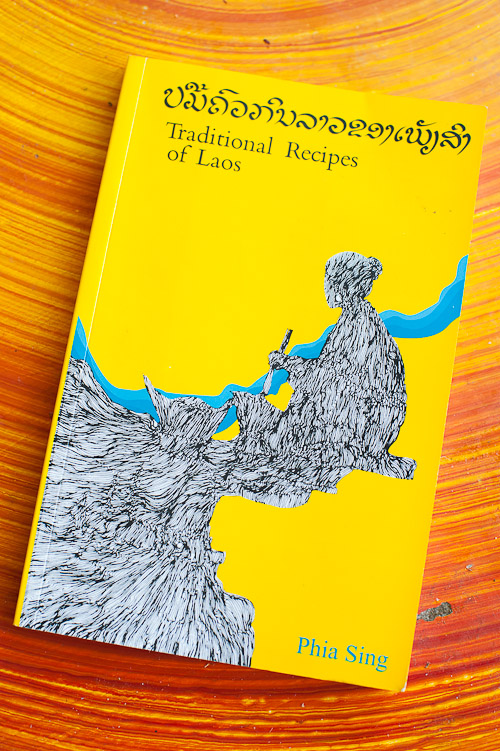 Not from me of course, but from Phia Sing, a former royal cook in the palace of Luang Prabang. The 115 recipes, originally written on notebook paper by Phia Sing, and later compiled and edited by former British diplomat,
Not from me of course, but from Phia Sing, a former royal cook in the palace of Luang Prabang. The 115 recipes, originally written on notebook paper by Phia Sing, and later compiled and edited by former British diplomat,  After two weeks in Vientiane I have to admit that I’ve found relatively little in the way of Lao food worth sharing. I’ve encountered one exceptionally good Lao restaurant, a decent phở' stall and a pretty solid night market, all of which I’ll blog about soon, but for the most part I get the impression that the vast majority of people here appear eat dinner at home, and when eating out, require little more a bit of grilled meat and Beerlao. This is unfortunate for visitors, as Lao food really can be good, but I imagine that much of what people manage to eat here is either gentrified for foreigners, or as is more often the case, just kinda crappy.
After two weeks in Vientiane I have to admit that I’ve found relatively little in the way of Lao food worth sharing. I’ve encountered one exceptionally good Lao restaurant, a decent phở' stall and a pretty solid night market, all of which I’ll blog about soon, but for the most part I get the impression that the vast majority of people here appear eat dinner at home, and when eating out, require little more a bit of grilled meat and Beerlao. This is unfortunate for visitors, as Lao food really can be good, but I imagine that much of what people manage to eat here is either gentrified for foreigners, or as is more often the case, just kinda crappy.
 Recently Global Post Thailand Correspondent
Recently Global Post Thailand Correspondent 
 Inside the Lao Brewery Company, Vientiane, Laos
Inside the Lao Brewery Company, Vientiane, Laos At the Lao Brewery Company outside Vientiane, Laos
At the Lao Brewery Company outside Vientiane, Laos Inside the Lao Brewery Company, Vientiane, Laos
Inside the Lao Brewery Company, Vientiane, Laos  Inside the Lao Brewery Company, Vientiane, Laos
Inside the Lao Brewery Company, Vientiane, Laos Glasses of Beerlao at a restaurant in Vientiane, Laos
Glasses of Beerlao at a restaurant in Vientiane, Laos At the Lao Brewery Company, located outside Vientiane, Laos
At the Lao Brewery Company, located outside Vientiane, Laos I'm updating the next edition of Lonely Planet's Laos guide, and have based myself in Vientiane, that country's capital. I've rented a colonial-era shophouse strategically located within walking distance from an excellent Lao restaurant, a traditional Lao sauna, the city's evening market, two very good French bakeries and the tam maak hung stall illustrated above. I'll most likely in Laos for the better part of the next three months, and you can look forward to dispatches on the places mentioned above, and more.
I'm updating the next edition of Lonely Planet's Laos guide, and have based myself in Vientiane, that country's capital. I've rented a colonial-era shophouse strategically located within walking distance from an excellent Lao restaurant, a traditional Lao sauna, the city's evening market, two very good French bakeries and the tam maak hung stall illustrated above. I'll most likely in Laos for the better part of the next three months, and you can look forward to dispatches on the places mentioned above, and more. After more than a decade in Bangkok, I’m still stumbling upon new entirely new dishes and places to eat. My latest discovery is an obscure intersection near Bangkok’s Chinatown that is home to several restaurants serving kuaytiaw khua kai, a fried noodle dish that’s also a relatively recent discovery of mine. The dish, which consists of wide rice noodles fried with chicken breast and pickled squid and served over lettuce, I first encountered at
After more than a decade in Bangkok, I’m still stumbling upon new entirely new dishes and places to eat. My latest discovery is an obscure intersection near Bangkok’s Chinatown that is home to several restaurants serving kuaytiaw khua kai, a fried noodle dish that’s also a relatively recent discovery of mine. The dish, which consists of wide rice noodles fried with chicken breast and pickled squid and served over lettuce, I first encountered at 






 Northern-style Chinese food is relatively hard to find here in Bangkok. This shouldn't come as a surprise, as most Chinese-Thais trace their roots back to southern China, and anyway, heavy wheat-based food isn't generally the first thing people reach for when they're sweating from every pore. So stumbling upon Khrua Paking (Beijing Kitchen) while actually in search of another restaurant, was a spot of good luck.
Northern-style Chinese food is relatively hard to find here in Bangkok. This shouldn't come as a surprise, as most Chinese-Thais trace their roots back to southern China, and anyway, heavy wheat-based food isn't generally the first thing people reach for when they're sweating from every pore. So stumbling upon Khrua Paking (Beijing Kitchen) while actually in search of another restaurant, was a spot of good luck.



 Located near Bangkok's historic
Located near Bangkok's historic 

 I often get emails from people en route to Bangkok asking me to recommend the best places in town to eat. I reply to these when I can, but sometimes the volume of mail can get overwhelming, so
I often get emails from people en route to Bangkok asking me to recommend the best places in town to eat. I reply to these when I can, but sometimes the volume of mail can get overwhelming, so 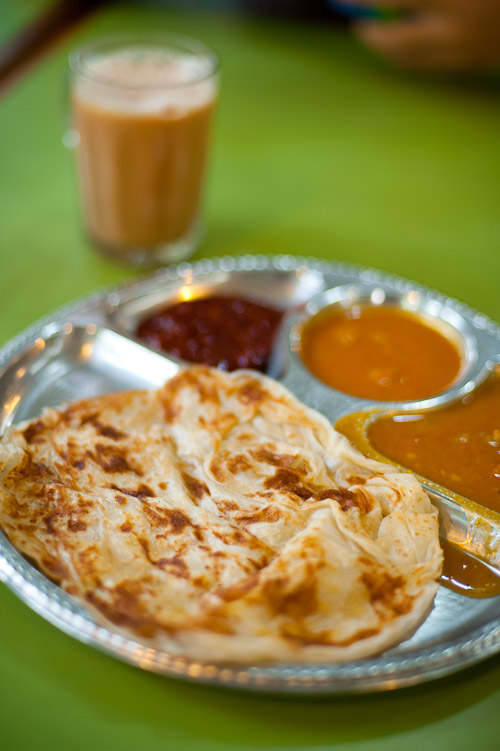 Combine roti canai, a type of fried flatbread served with a spicy dhal-based dipping sauce, teh halia, sweet ginger tea, and throw in a copy of
Combine roti canai, a type of fried flatbread served with a spicy dhal-based dipping sauce, teh halia, sweet ginger tea, and throw in a copy of  Last week I found myself in Kuala Lumpur, Malaysia,
Last week I found myself in Kuala Lumpur, Malaysia, 
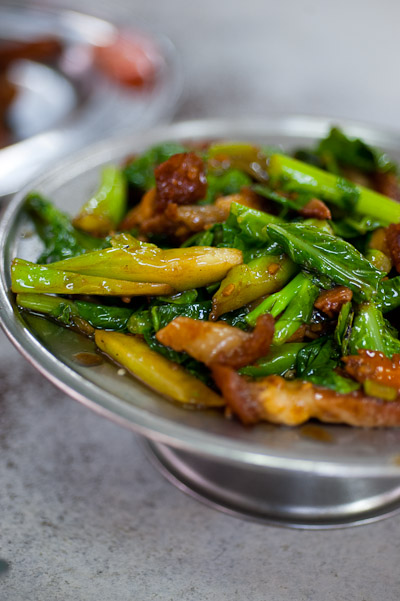
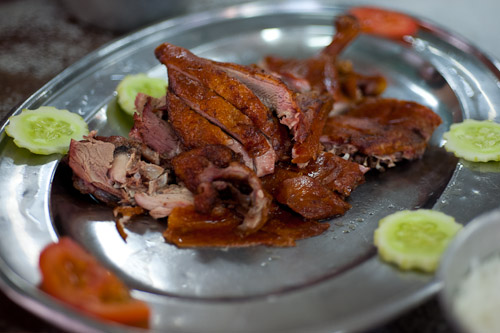
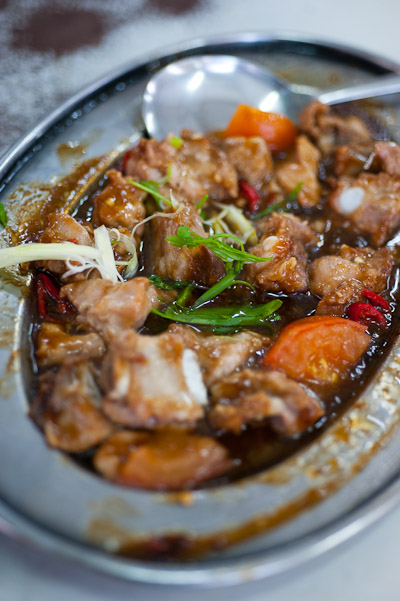
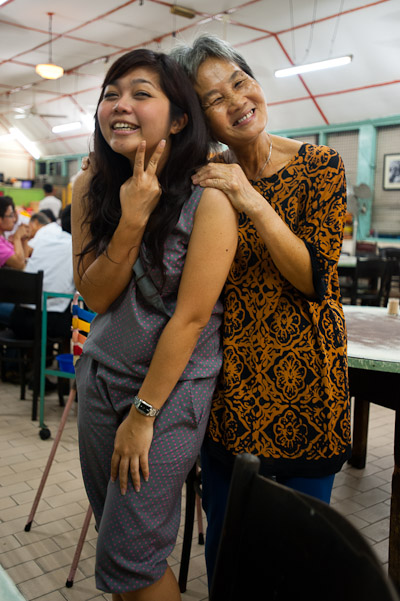
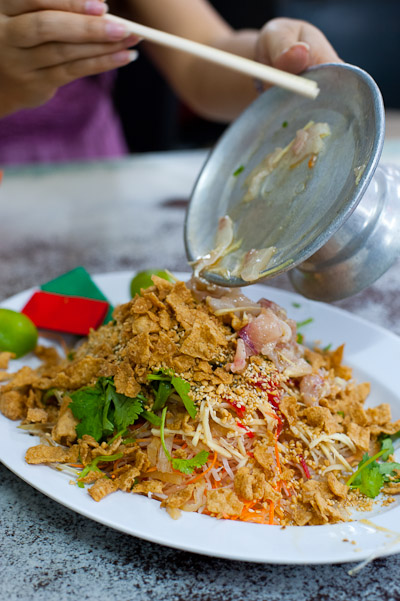
 20 rai of land, located just outside Mae Hong Song city, 3 million baht (approximately US$90,000).
20 rai of land, located just outside Mae Hong Song city, 3 million baht (approximately US$90,000). It's been a while since I've checked out
It's been a while since I've checked out 
 Khao puk ngaa, pounded sticky rice coated with ground sesame, a traditional sweet, Mae Hong Son
Khao puk ngaa, pounded sticky rice coated with ground sesame, a traditional sweet, Mae Hong Son Gourds for sale at Mae Hong Son's morning market
Gourds for sale at Mae Hong Son's morning market Last week I attended two of
Last week I attended two of 
 Handing out khao ya kuu on the streets of Mork Jampae, Mae Hong Son
Handing out khao ya kuu on the streets of Mork Jampae, Mae Hong Son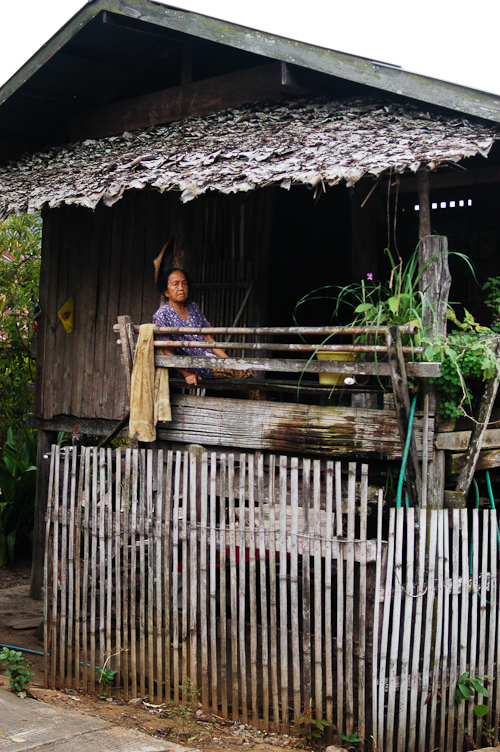 Typical Thai Yai house and resident, Mork Jampae, Mae Hong Son
Typical Thai Yai house and resident, Mork Jampae, Mae Hong Son